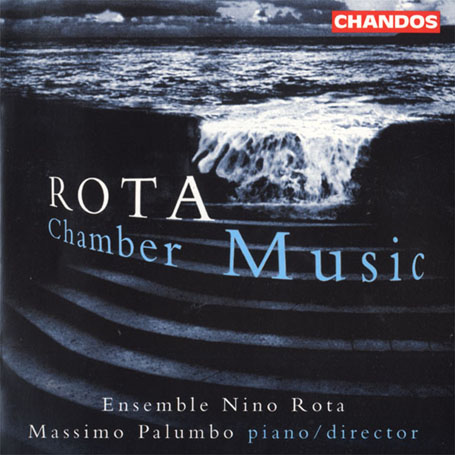Rota Chamber Works
Gentle musical surprises couched in the friendliest of terms, very nicely performed
View record and artist detailsRecord and Artist Details
Composer or Director: Nino Rota
Label: Chandos
Magazine Review Date: 11/2000
Media Format: CD or Download
Media Runtime: 63
Mastering:
DDD
Catalogue Number: CHAN9832

Tracks:
| Composition | Artist Credit |
|---|---|
| Sonata for Viola and Piano No. 1 |
Nino Rota, Composer
Massimo Palumbo, Piano Nino Rota, Composer Suela Mullaj, Viola |
| Sonata for Violin and Piano |
Nino Rota, Composer
Massimo Palumbo, Piano Nino Rota, Composer Suela Mullaj, Violin |
| Trio |
Nino Rota, Composer
Massimo Palumbo, Piano Nino Rota, Composer Paolo Ferrigato, Flute Suela Mullaj, Violin |
| Trio for Clarinet, Cello and Piano |
Nino Rota, Composer
Cecilia Radic, Cello Massimo Palumbo, Piano Nino Rota, Composer Paolo Beltramini, Clarinet |
Author: Rob Cowan
The one predictable element in Nino Rota’s chamber music is its melodic appeal, though I suppose you’d expect at least that much of a composer whose output includes numerous distinctive film scores. Here, the most ‘difficult’ piece is the lively Trio for Flute, Violin and Piano of 1958, neo-classical in style (the finale’s piano opening bars momentarily recall Mendelssohn’s E minor Scherzo – Trois fantaisies, Op 16) but with a mildly acerbic edge to its harmonic writing. It’s the most frequently recorded of Rota’s chamber works and the one piece in this particular programme that spells ‘nearly new’.
Rota composed the Trio for Clarinet, Cello and Piano six years before his death in 1979. Listen out for an unexpected sequence of quasi- Wagnerian modulations that set in a minute or so after the work has begun (the finale enjoys parallel rapture). This is the Rota of the film world, though elsewhere the style is more reminiscent of Poulenc or Prokofiev.
By contrast, Brahms takes the lead for the 1935 Viola Sonata, both in terms of winding melodies and the mellow complexion of Rota’s piano writing. The Violin Sonata from 1937 is filled with Southern warmth and has an amiable Allegro assai moderato follow-on from the slow movement without a break.
Massimo Palumbo’s recently formed Ensemble Nino Rota plays well throughout, with Suela Mullaj alternating on violin and viola (I’ve rarely heard a more viola-like violin tone). But the star performer of the team is unquestionably Palumbo himself, a discreet player whose sense of pianistic colour is a joy to behold. The recordings are close but clear, the annotation (Palumbo again) extremely informative, and the ‘bottom line’ of this release, musically speaking, is quietly original, easy on the ear and especially valuable for small chamber groups who seek to supplement their repertoires with accessible but unfamiliar material.'
Rota composed the Trio for Clarinet, Cello and Piano six years before his death in 1979. Listen out for an unexpected sequence of quasi- Wagnerian modulations that set in a minute or so after the work has begun (the finale enjoys parallel rapture). This is the Rota of the film world, though elsewhere the style is more reminiscent of Poulenc or Prokofiev.
By contrast, Brahms takes the lead for the 1935 Viola Sonata, both in terms of winding melodies and the mellow complexion of Rota’s piano writing. The Violin Sonata from 1937 is filled with Southern warmth and has an amiable Allegro assai moderato follow-on from the slow movement without a break.
Massimo Palumbo’s recently formed Ensemble Nino Rota plays well throughout, with Suela Mullaj alternating on violin and viola (I’ve rarely heard a more viola-like violin tone). But the star performer of the team is unquestionably Palumbo himself, a discreet player whose sense of pianistic colour is a joy to behold. The recordings are close but clear, the annotation (Palumbo again) extremely informative, and the ‘bottom line’ of this release, musically speaking, is quietly original, easy on the ear and especially valuable for small chamber groups who seek to supplement their repertoires with accessible but unfamiliar material.'
Discover the world's largest classical music catalogue with Presto Music.

Gramophone Digital Club
- Digital Edition
- Digital Archive
- Reviews Database
- Full website access
From £8.75 / month
Subscribe
Gramophone Full Club
- Print Edition
- Digital Edition
- Digital Archive
- Reviews Database
- Full website access
From £11.00 / month
Subscribe
If you are a library, university or other organisation that would be interested in an institutional subscription to Gramophone please click here for further information.




